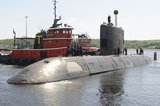DST developing maritime application for SPAD technology
Australia’s Defence and Science Technology (DST) is developing a maritime application for its single-photon avalanche detector (SPAD) technology, the DST announced on 10 April.
The project aims to develop a SPAD sensor and laser system that can be mounted on a gimbal on a hovering UAS tethered above the ocean surface to scan the depths for underwater vehicles and sea mines.
Partly funded by the Royal Australian Air Force’s Plan Jericho, the team has tested the sensor mounted on a wharf, and on a vessel at sea. The team measured the open water transparency using Secchi disks, the disks that are lowered into a water body until no longer visible. This depth of disappearance, called the Secchi depth, is a measure of the transparency of the water.
The SPAD sensors are designed for low-light detection of objects. With 256×256 pixels of resolution, the new version of the SPAD chip will improve the sensor's capability. Two chip layers will be joined together to create an advanced sensor.
Initial trials with a custom-built, heavy-lift, unpiloted multicopter version of the SPAD system were recently conducted over the waters off the South Australian coastline. The next stage of work will focus on optimising optics and image processing.
More from Naval Warfare
-
![First made-in-Finland US Coast Guard Arctic Security Cutter to be delivered in 2028]()
First made-in-Finland US Coast Guard Arctic Security Cutter to be delivered in 2028
The first Arctic Security Cutter will be built by Rauma Marine Constructions to be deployed in the US Arctic waters.
-
![Will the US Navy surge production for OTH-WS missile?]()
Will the US Navy surge production for OTH-WS missile?
The USN is conducting a market search seeking additional sources capable of supplying 516 units of Over the Horizon – Weapons System Encanistered Missiles.
-
![Thales wins DE&S contract for portable autonomous command centres]()
Thales wins DE&S contract for portable autonomous command centres
The agreement to provide portable autonomous command centres to the UK Royal Navy will enhance the service’s Mine Counter Measure operations and further integrate autonomous and uncrewed systems into its fleet.
-
![Maritime defence in the Mediterranean faces challenges from vulnerable land power]()
Maritime defence in the Mediterranean faces challenges from vulnerable land power
As an indispensable energy crossroads, the Mediterranean is at serious risk from grey zone disruption. As navies increasingly employ AI data centres, what happens when cutting-edge defence technologies rely on the very infrastructure most susceptible to hybrid tactics?























